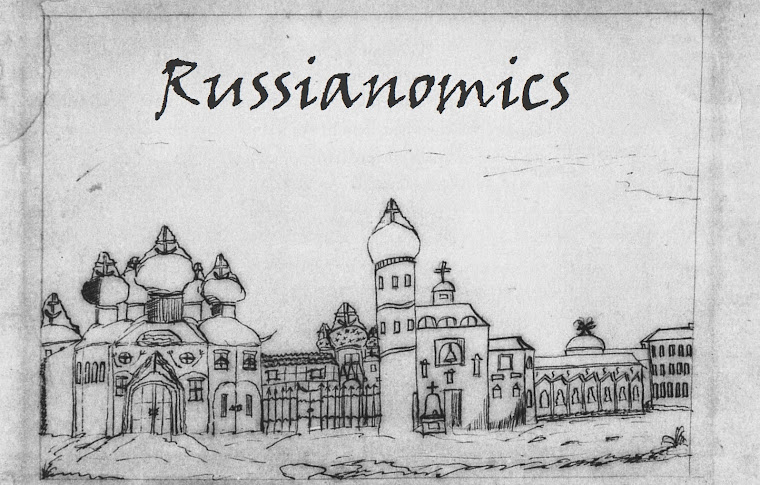Gewohnt breitbeinig stand Putin am vergangenen Freitag (4.11.) hinter dem Rednerpult, umgeben von Premier Medwedjew, Patriarch Kyrill und Regisseur Bondarchuk (eine Art russischem Til Schweiger). Trotzdem wirkte der Präsident, der sonst nur von schräg unten gefilmt wird, an diesem Tag winzig, fast zerbrechlich, so hoch türmte sich hinter ihm ein dunkler Koloss aus Bronze. Die Statue - eine XXL-Version des sowjetischen Ehrenmals im Treptower Park, minus Baby, plus Kreuz - ist dem Großfürst Wladimir gewidmet, der vor gut 1000 Jahren die Christianisierung der Kiewer Rus begann. Putin nannte den Fürsten in seiner Rede "Sammler und Verteidiger russischer Erde, weitsichtiger Politiker und geistiger Begründer des russischen Staats". Und dann heißt er noch Wladimir!
Anlass der Einweihung des Kunstwerks war der "Tag der Einheit des Volkes". Man müsse sich den heutigen Herausforderungen und Bedrohungen entgegenstellen, das sei man dem Fürsten schuldig, so der Präsident weiter (das war dem Internetportal der orthodoxen Kirche
eine Überschrift wert). Dabei mögen viele an die Widersacher im Westen gedacht haben, aber an diesem Feiertag schwingt auch etwas anderes mit: Um die Einheit des Volkes, vor allem seiner Elite, macht man sich im Kreml derzeit mindestens genau so viele Sorgen.
Diesen Eindruck hinterlassen die personellen und institutionellen Veränderungen der letzten Monate. Mit der Nationalgarde wurde im Juli ein schlagkräftiges Sicherheitsorgan geschaffen, dessen primäre Aufgabe die
Sicherung der Machtvertikale sein dürfte. Gleichzeitig gab es in den letzten Monaten eine große Zahl personeller Veränderungen in der russischen Führung. Mit Waino und Kirijenko sind zwei Politiker an die innenpolitische Schaltstellen der Präsidialadministration vorgerückt, die zumindest krisenerfahren sind (auch wenn ihre Ernennung
derzeit viele Fragen offen lässt). Kirijenko, in dessen Aufgabenbereich die Organisation erfolgreicher Präsidentschaftswahlen 2018 fällt, thematisierte zuletzt schon einmal die mögliche
Rückkehr separatistischer Bewegungen.
Natürlich ist es die Wirtschaftskrise, die diese Sorgen begründet. Zwar sind sich viele Ökonomen inzwischen einig, dass der
Tiefpunkt der Rezession überwunden ist. Auch schien sie bisher politisch kaum Auswirkungen zu haben. Allerdings wurden die Ausgaben des föderalen Haushalts, der ein wichtiges Instrument zur politischen Umverteilung an loyale Eliten und Bevölkerungsschichten ist, bisher (nominal) nicht verkleinert, sondern 2015 und 2016 jeweils noch ausgedehnt (
ein Überblick über aktuelle Haushaltszahlen). Möglich war dies durch die Geldpolitik der Zentralbank, die die Energie-Einnahmen des Haushalts abfederte und den Verbrauch der Reservefonds (die in ausländischen Devisen investiert sind) verlangsamte.
Die verbliebenen Mittel in den staatlichen Fonds (Reservefonds:
2,5% des BIP, wird zum Teil noch für 2016 benötigt; Wohlfahrtsfonds FNB:
5,8% des BIP, allerdings ist der FNB nur zur Hälfte in liquiden Mitteln angelegt) können das voraussichtliche Defizit der kommenden zwei Jahre gerade so decken (
2017: 3,2% des BIP, 2018: 2,2% des BIP). Allerdings enthält der Haushaltsplan für das nächste Jahr eine drastische Kürzung des Verteidigungsbudgets: Dieses soll um ein gutes Viertel schrumpfen. Auch wenn das diesjährige Verteidigungsbudget besonders groß war, weil der Staat für große Kredite von Rüstungsunternehmen eingesprungen ist, so bleibt die Veränderung sehr deutlich.
Das Problem ist: Auch wenn die Wirtschaftskrise überstanden ist, kann der Haushalt nicht wieder wachsen. Der Grund ist die Energieabhängigkeit des föderalen Budgets. Seit Putins erster Amtszeit ist der Anteil der Einnahmen aus Öl und Gas
von 9% auf über 50% gestiegen. Der niedrige Ölpreis trifft den föderalen Haushalt um ein Vielfaches stärker als die russische Wirtschaft insgesamt. Gleichzeitig spricht vieles dafür, dass die Ölpreise in den nächsten Jahren moderat bleiben werden. Inzwischen gehen nur noch wenige Beobachter davon aus, dass die OPEC sich am 30. November in Wien zu einer signifikanten Reduktion der Förderung durchringen kann. Die
Anzahl der Förderanlagen in den USA steigt wieder. Zuletzt schockierte ein drastischer Anstieg der amerikanischen Lagerbestände die Märkte und ließ den Ölpreis auf ein 6-Wochen-Tief fallen.
Das Finanzministerium plant also, dass die Staatsausgaben von aktuell 20% des BIP
bis 2019 auf 16% des BIP und langfristig auf 14% des BIP zurückgehen. Der kleinere Staatshaushalt trifft die Möglichkeiten der politisch motivierten Umverteilung empfindlich. Es wird in den nächsten Jahren schlicht nicht möglich sein, Verteidigung UND Sozialausgaben auf derzeitigem Niveau zu finanzieren. Auch die Transfers an die Regionen
werden sinken. Aber wer verzichtet auf wie viel? Hier bahnen sich in den nächsten Jahren Verteilungskonflikte an.
Erste Anzeichen davon sind sichtbar: Der tschetschenische Präsident Kadyrow hält die Kürzungen seiner Zuwendungen für
unannehmbar und sieht die Entwicklung der Teilrepublik (deren Budget zu über 80% aus Moskauer Dotationen finanziert wird) in Gefahr. Verteidigungsminister Schoigu und Finanzminister Siluanow
stritten im Septemer lautstark über die zukünftigen Rüstungsausgaben - vor den Augen Wladimir Putins. Das Verteidigungskommittee der Duma
hält es für unzulässig, dass die Gehälter der Militärs nicht mehr nach Gesetz steigen sollen.
Und Igor Setschin macht deutlich, dass er die Milliarden "seines" Staatskonzerns Rosneft nicht ohne
Gegenleistung an das Budget überweisen will. Die staatliche Energieholding Rosneftegaz, über die der Staat Anteile an Gazprom und Rosneft verwaltet,
weigerte sich zuletzt ihre Gewinne an das Wirtschaftsministerium mitzuteilen, nachdem das Finanzministerium diese
komplett einziehen wollte. Rosneftegaz
deponiert sie lieber bei der Gazprombank, die von alten Freunden Putins aus dem Datschen-Verein "Ozero" kontrolliert wird. Ein älteres Zitat von Igor Setschin ergibt so neuen Sinn: "Was für einen Unterschied macht es, ob etwas privates oder staatliches Eigentum ist?" (aus
Hanson 2009).
Die etwa anderthalb Jahre bis zur Präsidentschaftswahl 2018 werden also spannend. Putin braucht ein starkes Mandat, denn die vierte Amtszeit, so viel ist klar, wird mit Abstand seine schwerste. Er benötigt die klare Unterstützung aus dem Volk, die "überwältigende Mehrheit", wenn er in den kommenden Verteilungskonflikten ein erfolgreicher Schiedsrichter sein will. Ein Resultat wie bei den Duma-Wahlen - zahlenmäßiger Sieg bei allgemeiner politischer Apathie - wäre dafür zu wenig.








